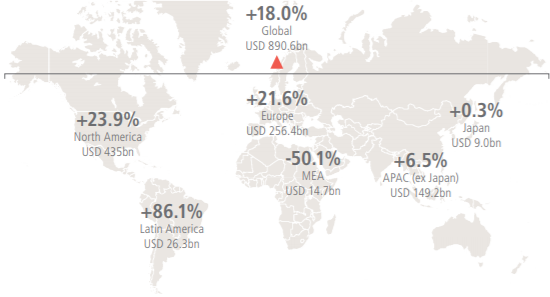
UBS: Booming M&A - what’s the big deal?
Global M&A activity in the first three months of 2018 was the strongest on record. Investment Insights looks at the macroeconomic drivers to this boom in deals, whether they are likely to continue and what this says about the economic cycle.
26.07.2018 | 13:00 Uhr
– Global Merger & Acquisition (M&A) accelerating to record levels as cash-rich corporate balance sheets, strong corporate confidence, low borrowing costs combine with robust global growth backdrop to drive deal flow.
– Disruptive technologies, structural industry change are major factors in increasing corporate activity across telecoms, media, IT, healthcare, pharmaceutical and retail.
– Shareholder activism, private equity cash pile increasingly powerful long-term supports to M&A.
– Cross-border deal flow remains strong despite geopolitical risks as digital due diligence tools de-risk M&A and aid integration.
– 2007 revisited? We see structural and strategic motivations rather than synergy-led growth for growth’s sake as the major drivers to M&A. Scant evidence of late cycle excess to-date.
– Rising M&A likely to act as ongoing support to global equities.
Exhibit 1: Global M&A Q1 2018 values, % change v Q1 2017.

Source: Mergermarket’s Global and Regional M&A Report Q1 2018
After an 18 month delay due to anti-trust objections raised by the US Department of Justice, the completion of the USD 85bn takeover of media group Time Warner by telecoms giant AT&T in June to create a ‘media vertical’ is seen by many as opening the floodgates to further major deals in the telecoms and media sectors. But if the blurring of the lines between traditional media and technology is likely to drive a swathe of other major content and distribution tie-ups, the two sectors are hardly alone in seeing an increase in corporate activity.
According to Mergermarket’s Global and
Regional M&A Report Q1 2018, the value
of M&A globally in the first three months
of the year was USD 890.6bn, up 18%
yoy and the strongest start to the year
since Mergermarket’s records began in
2001. With 14 ‘megadeals’ above USD
10bn across business services, energy,
construction, real estate and consumer
sectors, the figures are notable for their
breadth by sector and geography, as
well as for their scale. More recent
newsflow, including the AT&T/Time
Warner decision, suggests no let-up in
the pace of activity since the end of Q1.
The key question for investors is whether
this M&A boom is a short-term anomaly
or something more substantial and
sustainable that will influence markets
over a meaningful horizon. We believe it
is the latter. In truth, the case for
increasing M&A globally over the next
one to two years was already compelling
even before the US government’s
objections to the AT&T/Time Warner
deal were so comprehensively dismissed.
Backed by a perfect storm of strong
global growth, cash rich corporate
balance sheets, low borrowing costs,
high levels of corporate confidence and
technology-led structural change across
industries, 2018 was already shaping up
to be a record year of corporate activity.
Return of animal spirits
With global growth rates comfortably
above-trend and US economic momentum
particularly robust, the demand
backdrop certainly appears conducive to
deal making and, in our view, is likely to
remain so. Corporate confidence in this
environment remains high. According to
NFIB’s Small Business Optimism Index in
the US, confidence is at a 34-yr high—
helped by all-time highs in some index
components including expectations
for business expansion and positive
earnings trends.
In a recent survey by global consultancy
EY, (Global Capital Confidence Barometer,
April 2018), some 86% of the corporate
and private equity respondents said they
expected the overall M&A market to
improve over the next 12 months. Strong
corporate earnings, particularly in the
US, and a belief that credit availability
will remain strong are the key ingredients
here alongside the return of animal
spirits in corporate America. Doing deals
clearly involves risk. We therefore see
current high levels of corporate optimism
as an important support to M&A.
Tax cuts supporting
US deal flow
A key driver of US corporate confidence
comes from recent tax reform. Indeed,
the Tax Cuts and Jobs Act has changed
the tax landscape in a sufficiently
material way to be a driver of increased
M&A activity in itself. In simple terms,
the reduction in the federal corporate
income tax rate from 35% to 21%, the
introduction of a territorial tax system
(tax free dividends from overseas
subsidiaries), and the provisions for the
repatriation of cash held in overseas
subsidiaries by US corporates are in
aggregate likely to increase cash on
balance sheets immediately, in some
cases considerably. The tax reform
therefore provides additional firepower
for M&A deals as well as making
domestic US targets more attractive.




Diesen Beitrag teilen: